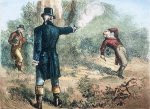By Stockton
This is the first part of a two part series on briefing case law and reading case law.
A time honored law school tradition and one of the last pure delights on earth is briefing case law.
What is Case Law?
Case law is the law found in 'Case Books', those curvature of the spine-inducing texts lugged around by law students. Case Books are choked full of judicial opinions handed down by appellate courts. The losing side of a suit, angry at its loss, typically appeals a decision or jury finding. The winning side opposes that appeal, believing everything went fine. The two sides argue before an appellate court. The appellate court, having made up its mind weeks before, listens to the arguments and then issues a written decision months later. Some of these decisions find their way into Case Books and become known as case law.
Case law is studied because it either illuminates a difficult legal concept or obscures a simple legal concept, allowing future lawyers to feel vaguely confident of shadowy legal concepts. It is also used to show the student how dumb lower court judges can be. It is the students responsibility to read and digest these cases and to be ready to avoid all eye contact with the professor during class.
Because students generally have anywhere between ten and three hundred cases to read every night, the cases must be briefed.
What is a Brief?
A brief is a succinct summary of the salient points of a case and usually contains the following:
1) The issue;
2) The rule of law;
3) The application of the rule of law to the facts;
4) Doodles;
5) Primitive sketches of your professor and small furry animals.
Briefing Styles and Techniques
There are as many briefing styles and techniques as there are law students. In fact, there are more briefing styles and techniques than law students because a student's style tends to evolve over the first year (ultimately devolving into not reading anything but the local newspaper's sports page in the third year).
The Super-Sized Brief or Anti-Brief
The super-sized brief is longer than the actual case it purports to summarize. It's the favorite technique of the nervous, stressed-out over-achiever. In fact, one suspects that the super-sized brief is nothing more than the actual case re-written in the student's hand. For the super-sizer, no fact, no detail is irrelevant. The super-sizer will even draft a mini-super-sized brief for the dissenting opinion.
When called on in class, the Super-sizer will tell you the names of the judges, their favorite colors and the year of the decision.
This technique is traditionally short-lived due to a high incidence of carpal tunnel syndrome.
The Underline
This style is for those that do not like writing actual words. The underliner wants to streamline the process as much as possible so he merely underlines everything he would have written down in a traditional brief. During the course of your law school career you will eventually sit next to The Underliner. You will glance over at his text book to find almost every line of the decision underlined.
Naturally, when called upon, the Underliner will glance frantically at his 'Brief' and choke.
The Rainbow Brief
Personally, this is my favorite. Some student, typically an anxious female, will take it into her head to color code her textbook. For example, she will highlight the procedural history in yellow, the facts in green, the issue in orange, the analysis in blue, the rule in orange and dicta in red. This student has spent many hours perfecting her color code and will promptly forget it when the professor calls upon her ('Was red for facts? Green for the issue? I don't know...)*
The Brief, What is it Good For?
The main purpose of a brief is to help you not make a complete jack-ass out of yourself in front of the entire class. If done properly (ie. in brief) a brief will help jog your memory when called upon in class. That is, if you can read your own handwriting. Make it simple: issue; rule; application of the rule to the facts; obscene doodles. The brief should be no longer than one side of one piece of paper even if the case is seventy-three pages long. If you are not called upon, that day's briefs may be crumpled up and tossed at your friends or used to start a fire in your dorm room.
* Never look directly at a Rainbow Brief. Severe retinal damage may occur. If you have to look at a Rainbow Brief, poke a hole in a shoe box and view the brief through the hole.
Saturday, November 06, 2004
Subscribe to:
Post Comments (Atom)


1 comment:
Rainbow briefs just aren't for females anymore.
Post a Comment